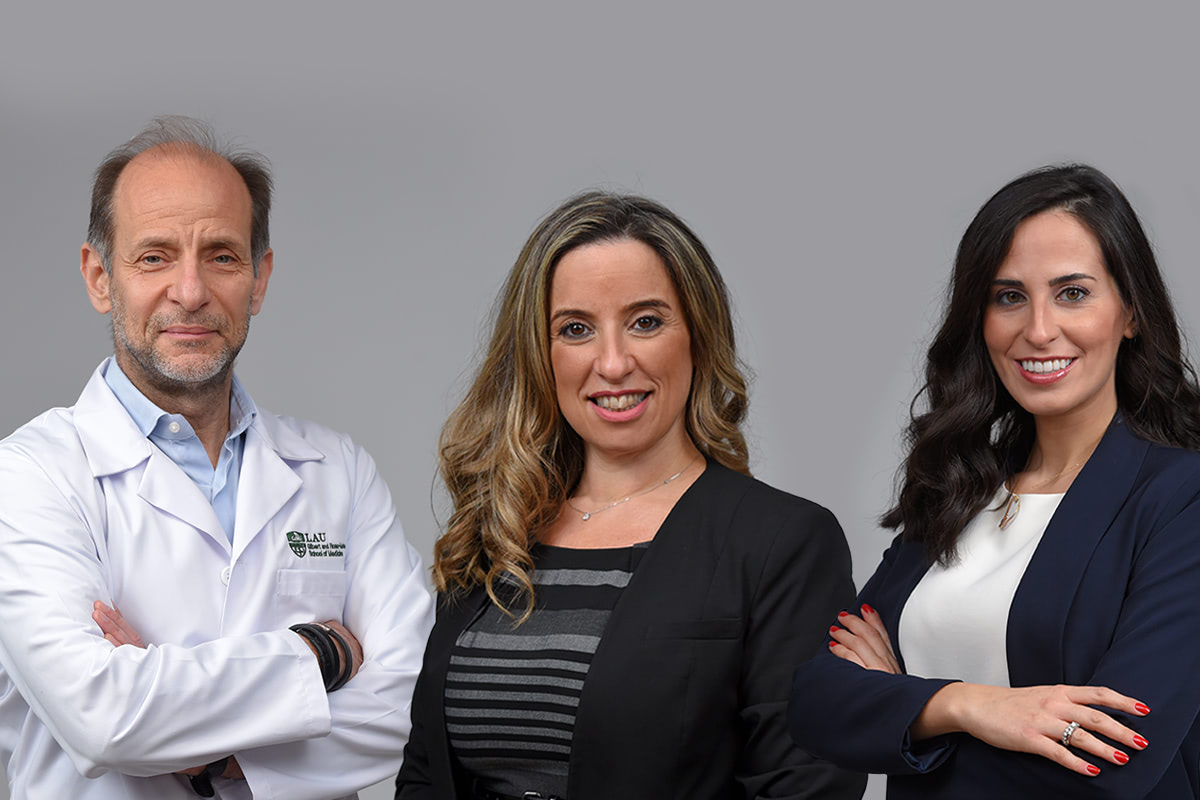LAU Team Discovers Novel Genetic Disease Linked to POLD3 Gene
A research study conducted by the team at the Department of Human Genetics identifies a novel genetic disease linked to POLD3 deficiency.
Working at breakneck speed to save a life, and completing their research in under two months, Drs. Cybel Mehawej, Eliane Chouery and Andre Megarbane from the Department of Human Genetics at LAU’s Gilbert and Rose-Marie Chagoury School of Medicine discovered that POLD3 deficiency is associated with severe combined immunodeficiency, neurodevelopmental delay, and hearing impairment.
The team’s breakthrough discovery was published by Clinical Immunology. POLD3, a subunit of the DNA polymerase delta complex enzyme involved in DNA replication and repair, was linked to a human disease for the first time through this research.
Dean Sola Aoun Bahous praised the team’s dedication and passion for discovery, research, and education, calling their achievement a “giant leap” for the school of medicine and LAU. The team expressed their gratitude to LAU President Michel E. Mawad for the President’s Intramural Research Fund (PIRF), which made their groundbreaking work possible.
Can you tell us more about your research and findings?
Our research enabled us to link the gene POLD3 to a human disease for the first time, and thus to identify a novel genetic disease: POLD3 deficiency. This syndromic severe immune disease is associated with neurodevelopmental delay and hearing loss.
The work was performed on a five-year-old boy of first-cousin consanguineous Lebanese parents who had lost three of their kids, by the age of five, to the same disease. The affected individuals suffer from neurodevelopmental delay, hearing impairment, and a severe immune disease causing repetitive upper respiratory tract infections accompanied by fever and diarrhea.
Thanks to the PIRF grant, our team was able to discover the gene causing the disease in this family by Next Generation Sequencing and to validate the genetic defect suspected in the patient by performing additional studies on his cells (functional assays) to prove that the protein encoded by the gene POLD3 is completely absent. We also showed the total absence of additional proteins, POLD1 and POLD2, that are regulated by our candidate gene.
What was the impetus behind initiating the research?
Our team is specialized in the identification of the molecular bases of known genetic disorders and in gene identification, in other words in linking “new genes” to human diseases.
Identifying the gene involved in a patient’s disease enables us to confirm a clinical diagnosis, when the condition is already known internationally, or to establish a new diagnosis and describe a new genetic disease. This is the first step toward understanding the molecular pathways involved in the disease, and ultimately implementing appropriate therapeutic approaches and better clinical management of the patient, when possible.
In the current study, the family approached us for genetic counseling, to understand the cause of the disease and the risk of its occurrence in other children.
What challenges did you face and how were they resolved?
Unfortunately, these projects can be risky, as they have to be executed swiftly to ensure the performance of all required techniques and experiments with the shortest delays, and when possible, to help the patient after the confirmation of his diagnosis.
Time is of the essence. Primarily because the life of the patient is at stake as, in the absence of T lymphocytes – a major player in the immune system – the body is not able to fight infections.
Furthermore, the race with other international teams who might be working on the same pathway or lists of genes is an added pressure.
How are your findings significant to genetic research? What contributions do they make to the field?
Advances in the field have made genetic information available on a large scale, revolutionizing molecular diagnosis. However, to date, several challenges exist, mainly when it comes to interpreting the massively generated data. Of the 20,000 genes present in a human somatic cell, only around 4,700 have so far been linked to diseases in humans.
Therefore, research is still needed to establish the association between diseases and the remaining genes.
Identifying a new gene is the first step toward understanding the mechanism involved in this disease. Once the pathway/mechanism is known, scientists around the world can work on implementing new therapeutic approaches for affected patients.
Can your discovery be put into immediate practice in helping patients?
Yes. Interestingly in the field of immunogenetics – genetics related to immune diseases – therapeutic approaches can be tailored to the patient based on their genetic profile.
In other words, when we identify the gene involved in the disease, we may be able to guide the patient’s clinical management and suggest therapeutic approaches, such as bone marrow transplantation for patients with severe combined immunodeficiency.
For the current case, we have been communicating with international teams who promised to try and help secure a bone marrow transplant. But the process can be lengthy, even after the procedure, and may also require fundraising from our side to cover the expenses for the trip and accommodations of both the patient and his guardian.
How did LAU facilitate your research?
In addition to the PIRF, for which we sincerely thank LAU President Michel E. Mawad, we received great support from our colleagues. The faculty of the School of Pharmacy were very generous in sharing with us some common reagents needed in our experiments. In all, it was an interesting interdisciplinary collaboration between the various schools conducted entirely at our LAU labs and facilities.
To browse more scholarly output by the LAU community, visit our open-access digital archive, the Lebanese American University Repository (LAUR)
